Buick Roadmaster
| Buick Roadmaster | |
|---|---|
 | |
| Overview | |
| Manufacturer | Buick (General Motors) |
| Production |
1936–1958 1991–1996 |
| Body and chassis | |
| Class | Full-size |
| Layout | FR layout |
| Chronology | |
| Successor | Buick Park Avenue |
The Roadmaster is an automobile that was built by Buick from 1936 to 1958, and again from 1991 to 1996. Roadmasters produced between 1936 and 1958 were built on Buick's longest non-limousine wheelbase and shared their basic structure with entry-level Cadillac and, after 1940, senior Oldsmobiles. Between 1946 and 1957 the Roadmaster served as Buick's flagship, and when it was resurrected for the 1991 through 1996 model years it was the marque's largest vehicle.
1936–1937
| First generation | |
|---|---|
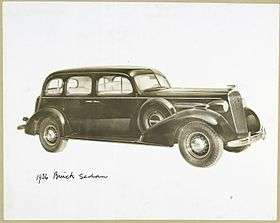 | |
| Overview | |
| Model years | 1936–1937 |
| Assembly |
South Gate, California, U.S. Flint, Michigan, U.S. Linden, New Jersey, U.S. |
| Designer | Harley Earl |
| Body and chassis | |
| Body style |
4-door sedan 4-door convertible |
| Platform | C-body |
| Related |
Cadillac Series 80 Cadillac Series 70 Cadillac Series 65 |
| Powertrain | |
| Engine | 320 cu in (5.2 L) Fireball I8[1] |
| Transmission | 3-speed sliding shift manual |
| Dimensions | |
| Wheelbase | 131.0 in (3,327 mm)[2] |
| Length | 210.3 in (5,342 mm) |
| Width | 75.0 in (1,905 mm) |
| Height |
1936: 69.5 in (1,765 mm) 1937: 68.0 in (1,727 mm) |
| Curb weight | 4,300–4,500 lb (1,950–2,040 kg) |
The origins of the Roadmaster name date to 1936 when Buick added names to its entire model lineup to celebrate the engineering improvements and design advancements over their 1935 models. Buick's Series 40 was named the Special, the Series 60 was named the Century and the Series 90 — Buick's largest and most luxurious vehicle — was named the Limited. The Series 50 was retired, but new for the model year was the Series 80 Roadmaster. The implications of the name were clear, for as the 1936 Buick sales catalogue said, "It literally named itself the first time a test model leveled out on the open highway."
The Roadmaster was introduced in a year when Buick's valve-in-head straight-eight engines were heavily revised. Buick reduced the number of engines from four sizes to two: a 233-cubic-inch, 93-horsepower job for the Special, and a big, 320.2-cubic inch, 120-horsepower engine for the other series. (To put the size and power of Buick’s larger straight-eight engine in context, compare it to the new 322-cubic-inch mono-block 120 horsepower V-8 that Cadillac introduced that year.) In addition to this major engineering change 1936 was also the year Buick adopted an all steel turret top and hydraulic brakes. Coil springs were in the front.[2]
The Roadmaster was a big car, in sedan form tipping the scales at 4,098 pounds, some 88 pounds heavier than Cadillac's new Series 60. But pricewise, the Roadmaster was a tremendous bargain. The sedan sold for $1,255, $440 less than the least expensive Cadillac. The only other body style available was a four-door convertible phaeton, priced at $1,565 (of which only 1064 were produced), at a time when a Cadillac in the same body style sold at prices ranging from $2,745 to $7,850. Buick’s new engineering and styling was a big hit, with model year sales more than tripling from just over 48,000 to nearly 158,000, and with the all new Series 80 Roadmaster contributing a total of 16,049 units to that number.
With Roadmaster being a completely new model, and with Buick having totally restyled its entire line for 1936, one might have expected only modest changes for 1937. But that was not the case. Buick was the only GM car, along with the Chevrolet Standard, to retain its basic 1934 styling for 1935, so the 1936 re-style merely caught Buick up with the rest of the GM marques. For 1937, Buick moved to newly re-styled bodies along with all other GM cars. The Roadmaster gained a divided grille with horizontal bars. The center section of the grille was painted to match the body of the car. Fenders became squared off and the headlight shells were gracefully streamlined. Overall height fell by 1.5 inches (38 mm) without sacrificing interior room. A new carburetor and revised camshaft raised engine horsepower to 130. The engine also received a new intake manifold, oil pump, cooling system and a quieter overhead valve mechanism. A formal sedan, featuring a roll-down glass partition between the front and rear compartments, was added to the Roadmaster line for $1,641, of which 452 were sold. The price of the sedan was raised to $1,518, and that of the phaeton to $1,856, or by 21 percent and 19 percent respectively. Nevertheless, overall Roadmaster sales increased to 16,129.
1938–1939

| Second generation | |
|---|---|
 | |
| Overview | |
| Model years | 1938–1939 |
| Assembly |
South Gate, California, U.S. Flint, Michigan, U.S. Linden, New Jersey, U.S. |
| Designer | Harley Earl |
| Body and chassis | |
| Body style |
4-door sedan 4-door convertible |
| Platform | C-body |
| Related | Cadillac Series 65 |
| Powertrain | |
| Engine | 320 cu in (5.2 L) Fireball I8 |
| Transmission | 3-speed sliding shift manual |
| Dimensions | |
| Wheelbase | 133.0 in (3,378 mm) |
| Length | 213.3 in (5,418 mm) |
| Width | 75.5 in (1,918 mm) |
| Height | 68.0 in (1,727 mm) |
| Curb weight | 4,200–5,100 lb (1,900–2,300 kg) |

Styling changes for 1938 were modest, with a longer hood extending to a now nearly vertical grill, taller bumper guards and redesigned hubcaps, but the effect was striking. Important changes were made to both engine and chassis. The ride was improved by replacing the rear leaf springs with coil springs, supported by double-acting shock absorbers that were some four times the size of any others on the market. The frame X-member was changed from I-beam to channel construction and all wood structural elements were replaced with steel. The engine combustion chambers were redesigned and new "turbulator" pistons raised the compression ratio from 5.9 to 6.5:1, resulting in an increase in horsepower to 141.
The 4-door convertible phaeton traded its built-in trunk look for a fastback appearance, and a new fastback sedan was added to the line with 466 being sold. The Roadmaster's price was increased, but not as swiftly as the previous year, going to $1,645 for the sedan. Although Buick’s overall market share increased in an off year, Roadmaster sales plummeted to 5568, falling from 7.3 percent to 3.3 percent of Buick's total output.
Styling for 1939 featured a new two-piece “waterfall” grille with thin vertical bars. The hood was narrower, front door pillars were narrower and hubcaps were larger. Window area increased substantially with the rear window changing to a one-piece design. On the interior all major gauges were moved to in front of the driver and the gear shift was moved to a column mount. The 4-door phaeton could now be ordered with the built-in trunk appearance or as a fastback, but only three of the later were actually sold. Although prices were reduced (the price of the sedan fell to $1545) sales only rose to 6097, with Roadmaster’s share of Buick’s total sales falling to 2.9 percent.
1940–1941
| Third generation | |
|---|---|
|
| |
| Overview | |
| Model years | 1940–1941 |
| Assembly |
South Gate, California, U.S. Flint, Michigan, U.S. Linden, New Jersey, U.S. |
| Designer | Harley Earl |
| Body and chassis | |
| Body style |
4-door sedan 4-door convertible 2-door coupe 2-door convertible |
| Platform | C-body |
| Related |
Cadillac Series 62 LaSalle Series 52 Buick Super Oldsmobile 90/96/98 Pontiac Torpedo |
| Powertrain | |
| Engine | 320 cu in (5.2 L) Fireball I8 |
| Transmission | 3-speed sliding shift manual |
| Dimensions | |
| Wheelbase | 126.0 in (3,200 mm) |
| Length |
1940: 214.0 in (5,436 mm) 1941: 215.0 in (5,461 mm) |
| Width |
1940: 75.8 in (1,925 mm) 1941: 76.5 in (1,943 mm) |
| Height | 66.1 in (1,679 mm) |
| Curb weight | 4,200–4,600 lb (1,900–2,100 kg) |
In 1940 the Series 80 was renamed Limited. The Roadmaster name was transferred to the new Series 70, which was introduced at the same time as a brand new Series 50 Super. The Roadmaster featured a cutting-edge "torpedo" C-body. The new C-body that the 1940 Buick Roadmaster shared with the Super, the Cadillac Series 62, the Oldsmobile Series 90, and the Pontiac Torpedo featured shoulder and hip room that was over 5" wider, the elimination of running boards and exterior styling that was streamlined and 2-3" lower. When combined with a column mounted shift lever the cars offered true six passenger comfort. These changes had clearly been influenced by the Cadillac Sixty Special.
The 1940 Roadmaster had a shorter wheelbase, was lighter, and was less expensive than the previous year’s model. The formal and fastback sedans were gone, but for the first time a 2-door coupe was available, which sold a respectable 3,991 units. Also new for this year, the coach-building firm of Brunn was asked to design several custom-bodied Buicks for the Series 70, 80 and 90. Only one Roadmaster example is known to have actually been produced in 1940, an open-front town car not surprisingly called the Townmaster. Overall sales more than tripled to 18,345.
The styling changes for 1941 were modest, but the changes under the hood were major. The compression ratio was raised from 6.6:1 to 7.0:1, the "turbulator" pistons were redesigned, smaller spark plugs were substituted for the previous type and “Compound Carburetion” was introduced. Compound Carburetion was the forerunner of the modern four-barrel carburetor, and consisted of twin two-barrel carburetors. One unit operated all of the time, while the other operated only under hard acceleration. The new engine delivered 165 horsepower. With five more horsepower than a senior Packard, 15 more than any Cadillac, and 25 more than the largest Chryslers, it was the most powerful engine available that year on an American car.
A new bodystyle for this year was a 2-door convertible, which sold 1,845 units. There was also one Brunn designed convertible produced, but priced at $3,500 actual orders for the vehicle failed to appear. Overall sales remained respectable at 15,372.
1942–1948
| Fourth generation | |
|---|---|
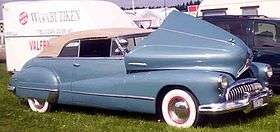 | |
| Overview | |
| Model years | 1942–1948 |
| Assembly |
South Gate, California, U.S. Atlanta, Georgia, U.S. Kansas City, Kansas, U.S. Flint, Michigan, U.S. Linden, New Jersey, U.S. |
| Designer | Harley Earl |
| Body and chassis | |
| Body style |
4-door sedan 2-door Sedanet coupe 2-door convertible 4-door Estate wagon |
| Platform | C-body |
| Related |
Cadillac Series 62 Buick Super Oldsmobile 98 |
| Powertrain | |
| Engine | 320 cu in (5.2 L) Fireball I8 |
| Transmission |
3-speed sliding shift manual 2-speed Dynaflow automatic |
| Dimensions | |
| Wheelbase | 129.0 in (3,277 mm) |
| Length |
1942: 217.0 in (5,512 mm) 1946–47: 217.1 in (5,514 mm) 1948: 217.5 in (5,524 mm) |
| Width | 78.6 in (1,996 mm) |
| Height | 66.1 in (1,679 mm) |
| Curb weight | 4,200–4,700 lb (1,900–2,100 kg) |
The 1942 Roadmaster was longer, lower, wider, and roomier than before (a Harley Earl trademark), thanks in part to a longer wheelbase. There was also a new vertical-bar grille and "Airfoil" fenders that swept back all the way to the rear fenders, which in subsequent generations became the chromed "Sweepspear". Both features became a Buick icon exhibited in one way or another for years to come, and were influenced by the concept car called the Buick Y-Job. The 4-door phaeton was dropped and would never return. Coupes adopted the appealing Sedanet fastback style that had been the sensation of 1941 on the Century and Special.
Effective at the beginning of 1942, new automobiles were available only to those in occupations deemed essential to the war effort. By mid-January, cars with no exterior chrome trim apart from the bumpers were being produced. By February passenger car production was shut down completely. Despite the abbreviated model year a total of about 8,400 were sold.
When postwar automobile production resumed in the 1946 model year, chrome was more sparingly applied, swept-back fenders were fitted to sedans as well as coupes, and a war-inspired "bombsight" hood ornament was adopted. The instrument panel was two-toned with woodgrain facings except on convertibles which used body-colored panels. Series identification was found on cloisonne emblems centered in the bumper guard front and rear. Compound Carburetion was eliminated and the compression ratio was reduced to 6.60:1. As a consequence the 1946 Roadmaster's horsepower fell from 165 to 144. Torque on the other hand was hardly affected. Nevertheless, Roadmaster’s I-8 still produced more horsepower than a top of the line Chrysler's. Due to wartime inflation prices were substantially higher. The biggest change was in sales proportions. Roadmaster increased its share of Buick sales from four percent in 1941 to 20 percent in 1946, with a total of about 31,400 sold.
In 1947 a new stamped grille with a separate upper bar was used. The Roadmaster name appeared in red-filled script on a chrome button within the bumper guard crossbars, front and rear. All new was an Estate wagon body style. It sold 300 units and instantly became the top of the line in the station wagon market.
In 1948 a series script appeared on the front fenders and the white Tenelite steering wheel that had been used previously was traded in for a black one, in order match the change from a two-tone woodgrain instrument panel to a two-tone gray instrument panel, with silver tone instruments. A new optional custom trim option was offered, consisting of cloth upholstery with leather bolsters with the robe cord cover and lower door panels trimmed in leatherette. Convertibles acquired power windows, seat and top as standard equipment. But the biggest advancement was the introduction of Dynaflow, the first passenger car torque converter transmission. Optional on Roadmaster in its first year, it was so popular that by the following it was standard equipment. Overall sales were just under 80,000 in both 1947 and 1948, over four times greater than in any prewar year.
1949–1953

| Fifth generation | |
|---|---|
 | |
| Overview | |
| Model years | 1949–1953 |
| Assembly |
South Gate, California, U.S. Wilmington, Delaware, U.S. Atlanta, Georgia, U.S. Kansas City, Kansas, U.S. Framingham, Massachusetts, U.S. Flint, Michigan, U.S. Linden, New Jersey, U.S. |
| Designer | Harley Earl |
| Body and chassis | |
| Body style |
4-door sedan 4-door Riviera sedan 2-door Sedanet coupe 2-door Riviera hardtop 2-door convertible 4-door Estate wagon 2-door Skylark convertible |
| Platform | C-body |
| Related |
Cadillac Series 62 Cadillac Series 61 Buick Super Oldsmobile 98 |
| Powertrain | |
| Engine |
320 cu in (5.2 L) Fireball I8 322 cu in (5.3 L) Nailhead V8 |
| Transmission | 2-speed Dynaflow automatic |
| Dimensions | |
| Wheelbase |
1949: 126.0 in (3,200 mm)[3] 1950-52 Riviera sedans: 130.3 in (3,310 mm) 1950–52 others: 126.3 in (3,208 mm) 1953 Riviera sedans: 125.5 in (3,188 mm) 1953 others: 121.5 in (3,086 mm) |
| Length |
1949: 214.1 in (5,438 mm) 1950 Riviera sedans: 214.9 in (5,458 mm) 1950 others: 210.9 in (5,357 mm) 1951–52 Riviera sedans: 215.0 in (5,461 mm) 1951-52 others: 211.0 in (5,359 mm) 1953 Riviera sedans: 211.6 in (5,375 mm) 1953 others: 207.6 in (5,273 mm) |
| Width | 79.9 in (2,029 mm) |
| Height | 63.0 in (1,600 mm) |
| Curb weight | 4,200–4,700 lb (1,900–2,100 kg) |
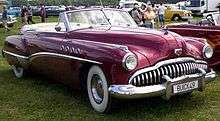

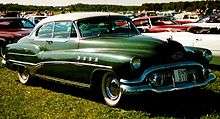
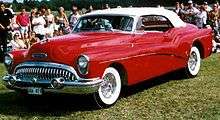
The Roadmaster received its first major postwar restyling in 1949. Its wheelbase and overall length were reduced but its weight was actually marginally increased. The biggest change was a much larger two-piece, curved glass windshield that the sales brochure described as like an “observation car.” It was also in 1949 that Buick introduced "VentiPorts." Four were displayed on each of the Roadmaster's front fenders,[4] with three on the fenders of all other Buicks. The sales brochure noted that VentiPorts helped ventilate the engine compartment, and possibly that was true in early 1949, but sometime during the model year they became plugged. The idea for VentiPorts grew out of a modification Buick styling chief Ned Nickles had added to his own 1948 Roadmaster. He had installed four amber lights on each side of his car’s hood wired to the distributor so as to flash on and off as each piston fired simulating the flames from the exhaust stack of a fighter airplane. Combined with the bombsight mascot, VentiPorts put the driver at the controls of an imaginary fighter airplane. Upon seeing this, Buick chief Harlow Curtice was so delighted that he ordered that (non-lighting) VentiPorts be installed on all 1949 Buicks, with the number of VentiPorts (three or four) corresponding to the relative displacement of the straight-eight engine installed.
Dynaflow was now standard equipment, and engine horsepower was increased to 150 and gave the new Buicks a top speed of 110 mph, through a slight increase in the compression ratio. In the middle of the year the Riviera, joined the body style lineup selling 4,314 units. Featuring power windows as standard equipment, the 2-door Buick Roadmaster Riviera, along with the Cadillac Series 62 Coupe de Ville and the Oldsmobile 98 Holiday, was among the first hardtop coupes ever produced. The Riviera was also notable for its popular optional "Sweepspear" chrome body side molding, which would soon become a Buick trademark. This chrome-plated strip started above the front wheel, after which it gently curved down nearly to the rocker panel just before the rear wheel, and then curved around the rear wheel in a quarter of a circle to go straight back to the tail-light. The "Riviera trim", as it was initially called, was also made available on the Roadmaster convertible very late in the model year. With a total of 88,130 sold, the all-time annual record for Roadmaster, the model accounted for 27 percent of all Buick sales, a remarkably high proportion in light of its price, which was only slightly less than a Cadillac Series 61.
The 1950 restyling featured a grille so toothy that Consumer Reports commented that "a toothbrush for the dentures comes extra." The Sweepspear had proved so popular in its first year that it was made standard on most body styles at the beginning of the 1950 model year, and on the station wagon and the new long wheelbase sedan mid-year. The long wheelbase sedan was stretched an extra four inches (102 mm). Like the convertibles, the Riviera and the extra plush long wheelbase sedan came with both power windows and power seats as standard equipment. Overall Roadmaster sales fell to 75,034, with Roadmaster’s share of total Buick output plummeting to 12 percent, thanks mainly to the surging popularity of the Special.
In 1951 the long wheelbase sedan was also called a Riviera although it was not a hardtop. The Sedanet and regular wheelbase sedan were cancelled.
Styling changes were minimal in 1951 and 1952. Power steering was added as an option in 1952 and horsepower climbed to 170 thanks primarily to a new four-barrel carburetor. Sales continued to slide falling to about 66,000 in 1951 and to 51,000 in 1952.
By 1953 the Roadmaster straight-eight was 16 years old and had become seriously dated. All of Roadmaster’s major competitors had shifted to short-stroke V-8 engines, and if Buick wanted to continue to be the paragon of longer, lower and wider, it needed one of its own. The new engine was ready in time for 1953, Buick’s Golden Anniversary year. Although the Nailhead (as it was popularly called) was nearly identical in displacement to the straight eight Fireball (322 versus 320 cubic inches), it was 13.5 inches (340 mm) shorter, four inches (102 mm) lower, and 180 pounds lighter, but with 188 horsepower, it was 11 percent more powerful. The compression ratio increased from 7.50:1 to 8.50:1 and torque increased from 280 to 300 pound-feet (410 N·m).
The compact dimensions of the V-8 engine enabled Buick to reduce Roadmaster’s wheelbase by 4.75 inches (121 mm) across the line, although styling differences behind the engine cowl, apart from new V-8 emblem hubcaps, were largely nonexistent. Buick also introduced a new "Twin-Turbine" Dynaflow as a companion for the V-8 engine. Estimated to increase torque at the wheels by 10 percent, the new transmission provided faster and quieter acceleration at reduced engine speeds. Both power steering and power brakes were made standard. Air conditioning was a new option and, years before many other makes, a 12-volt electrical system was adopted.
A new body style for 1953 was the Skylark convertible. The Buick Roadmaster Skylark was one of three specialty convertibles produced in 1953 by General Motors, the other two being the Oldsmobile 98 Fiesta and the Cadillac Series 62 Eldorado. The Skylark featured open wheel wells, a drastically lowered belt line, a four-inch-chop from the standard Roadmaster's windshield, the absence of VentiPorts and a new Sweepspear that anticipated Buick’s 1954 styling. Kelsey-Hayes wire wheels and a solid boot cover were standard. At $5,000 only 1,690 units were produced. The following year, and for one year only, it would become its own series built on a Century body. This was the last year for the Roadmaster Estate, and it was the last wood-bodied station wagon mass-produced in the United States. Its body was a product of Ionia Manufacturing which built all Buick station wagon bodies between 1946 and 1964. Priced at $4,031, the Estate was second in price only to the Skylark, with 670 being sold. Overall Roadmaster sales bounced back up to 79,137.
1954–1956

| Sixth generation | |
|---|---|
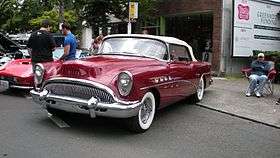 | |
| Overview | |
| Model years | 1954–1956 |
| Assembly |
South Gate, California, U.S. Wilmington, Delaware, U.S. Atlanta, Georgia, U.S. Kansas City, Kansas, U.S. Framingham, Massachusetts, U.S. Flint, Michigan, U.S. Linden, New Jersey, U.S. Arlington, Texas, U.S. |
| Designer | Harley Earl |
| Body and chassis | |
| Body style |
4-door sedan 4-door Riviera hardtop 2-door Riviera hardtop 2-door convertible |
| Platform | C-body |
| Related |
Cadillac Series 62 Buick Super Oldsmobile 98 |
| Powertrain | |
| Engine | 322 cu in (5.3 L) Nailhead V8 |
| Transmission | 2-speed Dynaflow automatic |
| Dimensions | |
| Wheelbase | 127.0 in (3,226 mm) |
| Length |
1954: 216.8 in (5,507 mm) 1955: 216.0 in (5,486 mm) 1956: 213.8 in (5,431 mm) |
| Width | 79.8 in (2,027 mm) |
| Height | 62.6 in (1,590 mm) |
| Curb weight | 4,400–4,600 lb (2,000–2,100 kg) |
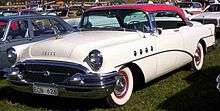
In 1954 Buick Roadmaster and Super shared with Cadillac and Oldsmobile 98 the new General Motors C-body, adopting the new "ponton" appearance, and the addition of "Dagmar bumpers" to the front. These were large, roomy cars, as much as five and a half inches longer in wheelbase and more than nine inches (229 mm) longer overall than in 1953. Roadmaster script was found on the rear quarters and within the deck ornament. Rear fenders had a blunted fin at the rear edge, with dual "bullet" taillamps below. A new panoramic windshield with vertical side pillars was used.[5] Seats had chrome bands on 2-door models and rear seats had an armrest on 4-door models. The front suspension was refined and Roadmaster's horsepower was increased to 200. The pillared coupe and the Estate wagon were no longer offered as body styles. Overall sales dropped to 50,600.
In 1955 broad lower rear fender bands, gold-colored Roadmaster deck script and hood ornament, bars on the hubcaps and gold-accented grille were added to distinguish Roadmaster. Horsepower jumped to 236, and a new variable-pitch Dynaflow, in which the stator blades changed pitch under hard acceleration, provided quicker off-the-line getaway. Back up lights were now standard. Overall sales were 64,500.
In 1956 Roadmaster had a shallower Sweepspear that did not dip all the way to the rocker panel as on other models. Twin chrome strips graced the decklid with Roadmaster spelled out between them. Roadmaster script now appeared on the doors beneath the vent windows. Fender tip dual bombsights were standard. Two stator wheels were adopted as an improvement to Dynaflow. A brand new 4-door Riviera hardtop, proved to be the most popular Roadmaster, with 24,770 units sold and outselling the pillared sedan by more than two-to-one. Overall sales were 53,500. A padded dash became standard.[6]
1957–1958

| Seventh generation | |
|---|---|
 | |
| Overview | |
| Model years | 1957–1958 |
| Assembly |
South Gate, California, U.S. Wilmington, Delaware, U.S. Atlanta, Georgia, U.S. Kansas City, Kansas, U.S. Framingham, Massachusetts, U.S. Flint, Michigan, U.S. Linden, New Jersey, U.S. Arlington, Texas, U.S. |
| Designer | Harley Earl |
| Body and chassis | |
| Body style |
4-door Riviera hardtop 2-door Riviera hardtop 2-door convertible |
| Platform | C-body |
| Related |
Cadillac Series 62 Buick Limited Buick Super Oldsmobile 98 |
| Powertrain | |
| Engine | 364 cu in (6.0 L) Nailhead V8 |
| Transmission | 2-speed Dynaflow automatic |
| Dimensions | |
| Wheelbase | 127.5 in (3,238 mm) |
| Length |
1957: 215.3 in (5,469 mm) 1958: 219.2 in (5,568 mm) |
| Width | 79.8 in (2,027 mm) |
| Height | 60.0 in (1,524 mm) |
| Curb weight | 4,500–4,900 lb (2,000–2,200 kg) |
| Chronology | |
| Successor | Buick Electra |
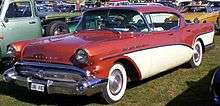

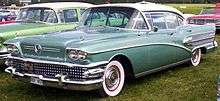
A lower body graced the 1957 Roadmaster with an even more panoramic windshield equipped with reverse slanted pillars. A red-filled Sweepspear lined the bodysides and a chromed rear fender lower panel filled the area between the wheelhouse and the bumper end, continuing to offer "Dagmar bumpers" at the front. A new centered fuel filler was found in the rear bumper, the ends of which the single or optional dual exhaust passed through. Roadmaster script was found within the deck and grille emblems. Two door models had a trio of chevrons on the rear quarters but the four door models had a Roadmaster emblem nestled within the Sweepspear dip. Interiors featured a padded dashboard and were broadcloth and nylon in 4-doors, nylon in 2-doors and leather in convertibles. There was a new 364-cubic-inch engine, developing 300 horsepower. A new ball-joint suspension system improved handling. Evidently the 4-door Riviera hardtop proved so popular on its introduction the previous year that the pillared sedan was dropped entirely from the model lineup. Also, new was a mid-year production ( March 1957) Roadmaster designated as Model 75 which was distinguished by standard power seats and windows, carpeted lower doors, a one piece rear window (instead of a three piece which were a steadfast design feature found only on the smaller Jr model lines of the Special and Century), Deluxe hubcaps and a Series 75 script found on the rear quarter body panel of the R.M. Coupes and the rear door panels on the R.M. 4-door sedans, thus replacing the standard 3 chevrons found in the same location on the standard full model year Roadmaster model lines. Nevertheless, overall Roadmaster sales plunged to about 33,000. However, this "sales plunge" was not an isolated occurrence found only at GM but was one shared by all manufacturers to one extent or another due to a capital market recession which effected the overall economy starting in late 1956 and extending into 1958.
For 1958, GM was promoting their fiftieth year of production, and introduced Anniversary models for each brand; Cadillac, Buick, Oldsmobile, Pontiac, and Chevrolet.[7] The 1958 models shared a common appearance on the top models for each brand; Cadillac Eldorado Seville, Buick Roadmaster Riviera, Oldsmobile Holiday 88, Pontiac Bonneville Catalina, and the all-new Chevrolet Bel-Air Impala.
In 1958 the Roadmaster could only be ordered as the well equipped Roadmaster 75, and its body was adorned with bulkier more heavily chromed styling. A new "drawer pull" grille was used, made up of rectangular chrome squares. For the first time since 1948 there were no distinguishing VentiPorts on the front fenders. On the rear deck the Roadmaster name was spelled out in block lettering beneath a Buick emblem housing the trunk lock keyway. Wheelhouses had bright moldings, rocker panels had an ebbed molding and a large rear fender bright flash with ribbed inserts replaced the previous year's chromed rear fender lower panel. Four headlamps were standard. New brakes, with cast iron liners in aluminum drums, proved to be the best in the industry. But sales fell further to about 14,000.
There was a complete restyling for 1959, but this time the names of the various series were changed. Not until 1991 would there again be a big Buick known as the Roadmaster; the largest Buick models were renamed the Electra.
1991–1996
| Eighth generation | |
|---|---|
 | |
| Overview | |
| Production | 1991–1996 |
| Assembly | Arlington, Texas, U.S. |
| Designer | Wayne Kady (1989) |
| Body and chassis | |
| Body style |
4-door sedan 5-door station wagon |
| Layout | FR layout |
| Platform | GM B platform |
| Related |
Buick Estate Chevrolet Caprice Chevrolet Impala SS Oldsmobile Custom Cruiser Cadillac Fleetwood (1993-1996) |
| Powertrain | |
| Engine |
5.0 L L03 V8 5.7 L L05 V8 5.7 L LT1 V8 |
| Transmission |
4-speed 4L60 automatic 4-speed 4L60-E automatic |
| Dimensions | |
| Wheelbase | 115.9 in (2,944 mm) |
| Length |
215.8 in (5,481 mm) (sedan) 217.5 in (5,524 mm) (1994–96 wagon) 217.7 in (5,530 mm) (1991–93 wagon) |
| Width |
78.1 in (1,984 mm) (sedan) 79.9 in (2,029 mm) (wagon) |
| Height |
55.9 in (1,420 mm) (sedan) 60.3 in (1,532 mm) (wagon) |
| Curb weight | 4,400–4,700 lb (2,000–2,100 kg) |
Buick revived the Roadmaster name for a B-body station wagon in 1991, replacing the Estate Wagon in the lineup. Using the 115.9-inch (2,940 mm) wheelbase that was introduced for the 1977 model year, the wagon was called the Roadmaster Estate Wagon. A sedan joined the wagon for 1992, with its own distinct sheet metal, although it shared parts with other full-size GM models. The Roadmaster Estate was a badge engineered Chevrolet Caprice Estate (also sold as the Oldsmobile Custom Cruiser) the three variants differing mainly in grille design and trim. It was slightly larger than the all-new Buick Park Avenue in 1991.
Simulated woodgrain side and back panels (made of vinyl) were standard on the Roadmaster Estate, although a delete option (WB4 wood delete) was available for credit. The "Vista Roof", a fixed sunroof over the second-row seats that was not available on the Caprice, was standard as well. The Roadmaster Estate could seat up to eight with an optional third-row seat. All these wagons initially used Chevrolet's 5.0 L small-block V8, but both Buicks used the larger 5.7 L version from 1992.
From 1994–1996, the Roadmaster, like all B-Body variants, began utilizing the iron head version of the Gen II LT1 V8, its 350 c.i/5.7 liters producing 260 hp (194 kW) and 335 lb·ft (454 N·m) of torque. The switch from the Gen I TBI 5.7L V8 was due to increasing standards for emissions and fuel economy that the aging Gen I could no longer meet. This motor was shared with the Impala SS of the same era and was related to the 4.3 L/265 c.i. L99 V8 that was the base motor for the Chevrolet Caprice, and varied mainly from the F body and Corvette applications by:
A) using iron heads rather than aluminum (specified by police departments for durability and utilized throughout the B-Body line) B) a milder cam that produced a better torque curve for the heavy B-Bodies. C) various intake silencers used to make the engine more palatable to the luxury market and/or pass drive-by noise standards. D) Two bolt main journal bearing caps (also true with the F-body LT1 engines, but not the Corvette).
The Roadmaster was only delivered with the 5.7 L LT1, however, and such cars can be detected visually by a factory-installed stainless steel dual exhaust. The interior of the LT1 cars are distinguished by utilizing analog gauges rather than digital. However, unlike its stablemates, the 9C1 Caprice and Impala SS the Roadmaster was limited to 108 mph (174 km/h) due to the factory-fitted tires not being rated to run the 140 mph (230 km/h) plus the 9C1 and SS were capable of. The engine returns 17 mpg-US (14 L/100 km; 20 mpg-imp) city/25 mpg-US (9.4 L/100 km; 30 mpg-imp) highway for a 4,200 lb (1,900 kg) full-sized car (4500 lb for the wagon), up 1 mpg-US city from the previous version.
The transmission from 1994–96 was changed from the 'analog' 700R4/4L60 to the electronically controlled version of the same, the 4L60E.
Ordered with the towing package, the 94-96 Roadmaster was advertised to tow up to 5000 pounds, although the Estate Wagon owner's manual extended that to 7,000 lbs when using a weight distributing hitch, dual sway controls, increasing the rear tire pressure to 35 psi and disabling the Electronic Level Control.[8] The tow package added 2.93 gears and a limited slip differential, heavy duty cooling system including oil and transmission coolers, and a factory installed self leveling rear suspension consisting of air shocks, a height sensor between the rear axle and body and an on-board air compressor. The most distinctive feature was the combination of one conventional fan driven mechanically from the engine alongside of one electric fan, offset to the left (non-towpack cars came with two electric fans).
GM discontinued both the Roadmaster sedan and the Roadmaster Estate in 1996, ending production on December 13 of that year.[9] This was blamed on the smaller but more expensive and luxurious Park Avenue growing in size; the Roadmaster trim levels never exceeded that of the smaller but still full-sized Buick LeSabre, as this enabled the Park Avenue to remain as Buick's flagship car. Interestingly, both the Park Avenue and LaSabre were front-engine front-wheel drive cars, in contrast to the Roadmaster's front-engine rear-wheel drive layout. Another reason was largely a response to the SUV craze, as the Arlington, Texas factory where the assembly line that specialized in RWD cars were built was converted to truck and SUV production. Along with the discontinuation of the related Cadillac Fleetwood and Chevrolet Caprice, this signalled the end of General Motors' production of rear-wheel drive, full-size cars. When discontinued, the Roadmaster Estate and the similar Chevrolet Caprice wagon brought up the end of the era of the full-size family station wagon.
Canada's prime minister from 1993–2003, the Right Honourable Jean Chretien, was driven in armoured Buick Roadmasters during his term of office.
-
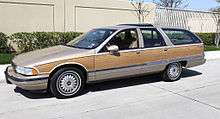
1993 Buick Roadmaster Estate
-

Buick Roadmaster Limited Estate Wagon
-

1993 Estate Wagon interior
Year-to-year changes
- 1992: A four-door sedan joined the Roadmaster wagon as an early 1992 model. The 5.7 L 180 hp TBI (Throttle-Body Injection) V8 engine replaced the 5.0 L.
- 1993: Window lockout feature and the addition of a new spoke wheel cover mid-year.
- 1994: A redesigned dashboard included a new instrument cluster, with climate controls mounted higher and a knee bolster below. A large pad containing the passenger airbag replaced the right half of the wood-look dash. The 5.7 L TBI LO5 is replaced with a 5.7L MPFI LT1. This LT1 had cast-iron cylinder heads and produced 260 hp (194 kW) (40 less horsepower than the Corvette). A new electronically controlled 4L60E four-speed automatic transmission replaces the 4L60 (aka 700R4).
- 1995: Only a handful of minor changes were made to 1995 models, including long-life automatic-transmission fluid. Larger, foldaway style mirrors were installed as well, and radios received bigger controls. Sedans wore new bodyside moldings, while Estate wagons added a shade for the "Vista Roof" as well as a cargo cover. Heated seats also became an option.
- 1996: Final year. Engine coolant could last 5 years or 100,000 miles (160,934 km), and automatic climate control became standard. General Motors also updated the on-board diagnostic system (OBD I to OBD II). The Roadmaster Estate Wagon and the Chevrolet Caprice wagon would be the last American full-size station wagons.
| Year | Units |
|---|---|
| 1991 | 7,291 (wagon only) |
| 1992 | 85,309 |
| 1993 | 40,449 |
| 1994 | 38,909 |
| 1995 | 30,508 |
| 1996 | 22,989 |
| Total production = 225,455 | |
References
- ↑ "Directory Index: Buick/1936_Buick/1936_Buick_Brochure_1". Oldcarbrochures.com. Retrieved 2011-12-30.
- 1 2 "Directory Index: Buick/1937_Buick/1937_Buick_Brochure". Oldcarbrochures.com. Retrieved 2011-12-30.
- ↑ "Directory Index: Buick/1949_Buick/1949 Buick Brochure". Oldcarbrochures.com. Retrieved 2011-12-30.
- ↑ Gunnell, John A. (ed.). Standard Catalog of American Cars 1946-1975. krause publications. ISBN 0-87341-027-0.
- ↑ "Owners Praise Buick Styling And Wrap Around Windshields." Popular Mechanics, June 1954, pp. 106-110.
- ↑ "Directory Index: Buick/1956_Buick/1956_Buick_Brochure_1". Oldcarbrochures.com. Retrieved 2011-12-30.
- ↑ Image of 50th Anniversary promotional photo
- ↑ "4". 1995 Buick Roadmaster Owner's Manual (First ed.). General Motors Corporation. 1994. pp. 4–34.
- ↑ Ward's Automotive Yearbook 1997. Ward's Communications, Inc. 1997.
- ↑ The Encyclopedia of American Cars, 2006 Edition
In 1995 9619 roadmasters were limited according to gm
External links
| Wikimedia Commons has media related to Buick Roadmaster. |
| Buick, a marque of General Motors, automobile timeline, United States market, 1940s–1970s — next » | ||||||||||||||||||||||||||||||||||
|---|---|---|---|---|---|---|---|---|---|---|---|---|---|---|---|---|---|---|---|---|---|---|---|---|---|---|---|---|---|---|---|---|---|---|
| Type | 1940s | 1950s | 1960s | 1970s | ||||||||||||||||||||||||||||||
| 6 | 7 | 8 | 9 | 0 | 1 | 2 | 3 | 4 | 5 | 6 | 7 | 8 | 9 | 0 | 1 | 2 | 3 | 4 | 5 | 6 | 7 | 8 | 9 | 0 | 1 | 2 | 3 | 4 | 5 | 6 | 7 | 8 | 9 | |
| Subcompact | Opel | |||||||||||||||||||||||||||||||||
| Skyhawk | ||||||||||||||||||||||||||||||||||
| Compact | Special | Apollo | ||||||||||||||||||||||||||||||||
| Skylark | Skylark | |||||||||||||||||||||||||||||||||
| Mid-size | Special | Special | Century | Century | ||||||||||||||||||||||||||||||
| Skylark | Skylark | Regal | Regal | |||||||||||||||||||||||||||||||
| Full-size | Special | Special | Special | Special | LeSabre | LeSabre | LeSabre | LeSabre | LeSabre | |||||||||||||||||||||||||
| Century | Century | Invicta | Invicta | Wildcat | Centurion | |||||||||||||||||||||||||||||
| Super | Super | Super | Super | Wildcat | ||||||||||||||||||||||||||||||
| Roadmaster | Roadmaster | Roadmaster | Roadmaster | Electra | Electra | Electra | Electra | Electra | ||||||||||||||||||||||||||
| Full-size station wagon | Estate | Estate | Estate | |||||||||||||||||||||||||||||||
| Personal | Skylark | Limited | Riviera | Riviera | Riviera | Riviera | Riviera | |||||||||||||||||||||||||||
| « previous — Buick, a marque of General Motors, automobile timeline, United States market, 1980s–present | |||||||||||||||||||||||||||||||||||||
|---|---|---|---|---|---|---|---|---|---|---|---|---|---|---|---|---|---|---|---|---|---|---|---|---|---|---|---|---|---|---|---|---|---|---|---|---|---|
| Type | 1980s | 1990s | 2000s | 2010s | |||||||||||||||||||||||||||||||||
| 0 | 1 | 2 | 3 | 4 | 5 | 6 | 7 | 8 | 9 | 0 | 1 | 2 | 3 | 4 | 5 | 6 | 7 | 8 | 9 | 0 | 1 | 2 | 3 | 4 | 5 | 6 | 7 | 8 | 9 | 0 | 1 | 2 | 3 | 4 | 5 | 6 | |
| Subcompact | Skyhawk | ||||||||||||||||||||||||||||||||||||
| Compact | Skyhawk | ||||||||||||||||||||||||||||||||||||
| Somerset | |||||||||||||||||||||||||||||||||||||
| Skylark | Skylark | Skylark | Verano | ||||||||||||||||||||||||||||||||||
| Convertible | Cascada | ||||||||||||||||||||||||||||||||||||
| Mid-size | Century | Century | Century | Regal | |||||||||||||||||||||||||||||||||
| Regal | Regal | Regal | LaCrosse | LaCrosse | |||||||||||||||||||||||||||||||||
| Full-size | LeSabre | LeSabre | LeSabre | LeSabre | Lucerne | ||||||||||||||||||||||||||||||||
| Electra | Electra | Park Avenue | Park Avenue | ||||||||||||||||||||||||||||||||||
| Roadmaster | |||||||||||||||||||||||||||||||||||||
| Full-size station wagon | Estate | Roadmaster Estate | |||||||||||||||||||||||||||||||||||
| Personal | Riviera | Riviera | Riviera | ||||||||||||||||||||||||||||||||||
| Subcompact crossover | Encore | ||||||||||||||||||||||||||||||||||||
| Mid-size crossover | Rendezvous | Envision | |||||||||||||||||||||||||||||||||||
| Full-size crossover | Enclave | ||||||||||||||||||||||||||||||||||||
| SUV | Rainier | ||||||||||||||||||||||||||||||||||||
| Minivan | Terraza | ||||||||||||||||||||||||||||||||||||
| Sports | Reatta | ||||||||||||||||||||||||||||||||||||